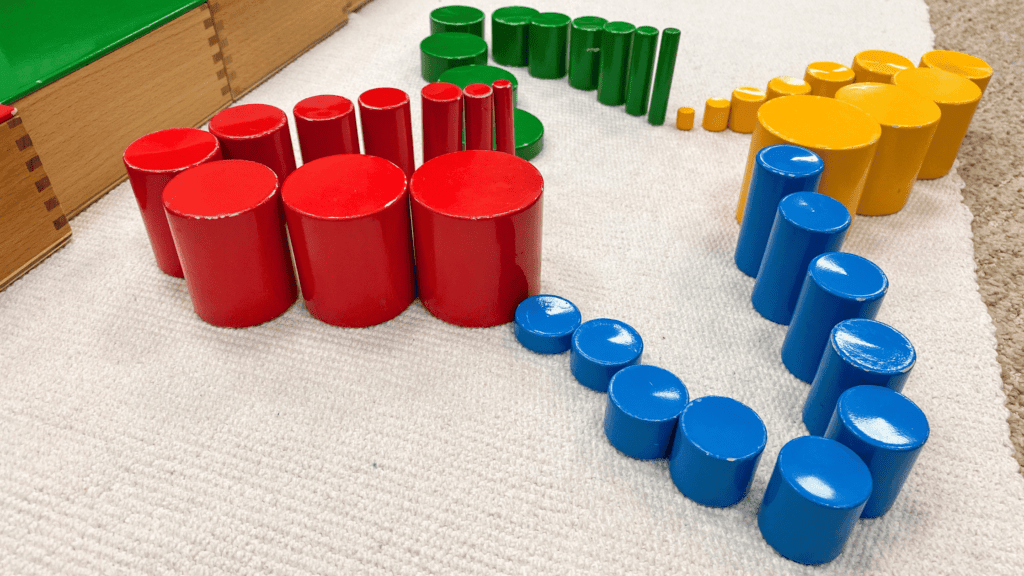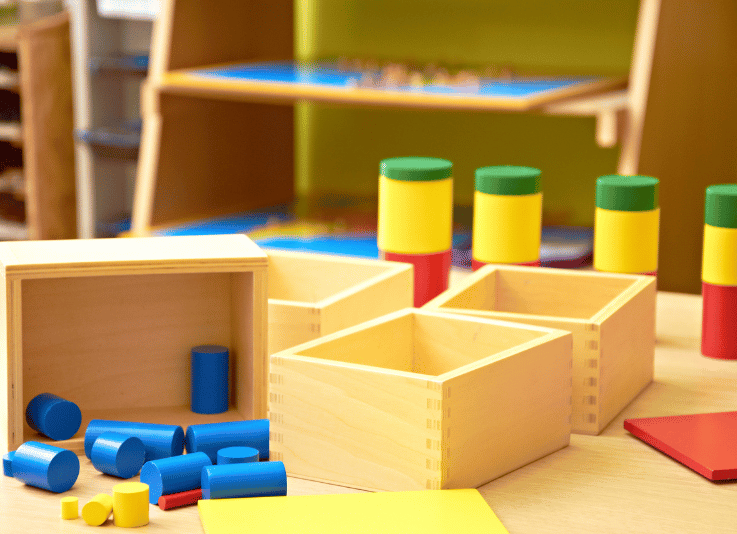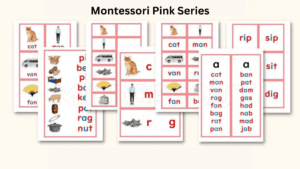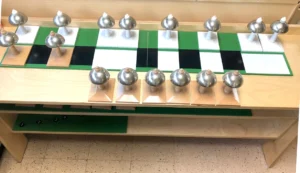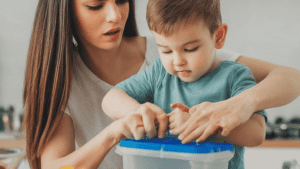Knobless cylinders are a part of Montessori sensorial curriculum to help them learn the visual differences. It is introduced to the children aged 3-6 years old i.e. at the primary level.
In this lesson, we will learn more about knobless cylinders, how they are introduced to the child and help them distinguish between objects and more activities related to it.
What are Knobless Cylinders?
Knobless cylinders are a Montessori sensorial material designed to help children develop visual discrimination, refine their tactile senses, and enhance their ability to notice and appreciate subtle differences in dimensions. It comprises four different colored sets(red, blue, yellow and green). Each box consists of 10 colored cylinders and is equipped with a lid that corresponds to its color.
What is the Purpose of Knobless Cylinders?
The primary purposes of knobless cylinders in the Montessori environment are to:
- Develop visual discrimination skills based on diameter and heights
- Refine the tactile sense
- Enhance concentration and focus
- Develop fine motor skills
- Introduce mathematical concepts such as seriation, ordering, and classification
What are Different Types of Knobless Cylinders?
There are four sets of knobless cylinders, each containing a different parameter for visual discrimination. Every collection of cylinders is intentionally diverse, systematically differing in either one or both dimensions: height and/or diameter.
- Blue knobless cylinder or the Set 1: Varying heights (Each cylinder decreases with the height but their diameter remains same)
- Red knobless cylinders or the Set 2: Varying diameters (Each cylinder reduces with the diameter but their height remains same)
- Yellow Knobless cylinders or the Set 3: Varying heights and diameters (Each cylinder decreases with diameter but increases with height)
- Green knobless cylinders or the Set 4: Gradation of both height and diameter (Each cylinder decreases with height as well as the diameter)
What are the Benefits of Knobless Cylinders?
The benefits of Montessori knobless cylinders are:
- Vocabulary: Engaging with knobless cylinders, children will learn the concept of thin, thick, tall and short and the grading between them. For example:
- short, shorter, shortest
- tall, taller, tallest
- thin, thinner, thinnest
- thick, thick, thickest
- Fine Motor Skills: Grasping and placing the cylinders without knobs require precision and control, developing fine motor skills.
- Mathematical Concepts: Knobless cylinders introduce mathematical concepts such as seriation, ordering, and classification, laying the foundation for more advanced math skills.
- Concentration and Focus: The process of arranging the cylinders engages the child’s concentration and focus, promoting mindfulness.
- Sensorial Development: The materials enhance the child’s sensory perception, particularly in terms of visual and tactile discrimination.
Prerequisites of Knobless Cylinder in Montessori Curriculum
A child must be introduced to the knobbed cylinders before introducing knobless cylinders.
Also read, Montessori geometric Solids
Control of Error
All the cylinders are visually different from each other. In other words, no 2 cylinders are identical.
Points of Interest
- The color of the sets
- The difference in size of each cylinder
How to Introduce Knobless Cylinders to the Child?
To introduce the knobless cylinders to the child, the order in which they must be introduced is very important i.e. red, yellow, green and then blue. Now, follow the below steps
- Invite the child to the table along with the knobless cylinders sets
- Begin by presenting the child with one set at a time starting with the red one.
- Upon uncovering the box, position it atop its lid and place it toward the upper left corner of the workspace.
- Using your thumb and two primary fingers, carefully, take out each cylinder one by one starting with the largest and start placing them in a row.
- Repeat step 4 with the rest of the 9 red cylinders.
- When introducing the cylinders keep mentioning the terms largest, larger, large….. Small, smaller and the smallest repeatedly.
- Ask the child some questions like, “do you see anything common among these cylinders”, “Have you noticed any change in each cylinder”
- Let the child answer yes and no. Followed by the answer and the concept of small and tall
- Allow the child to explore the cylinders independently, reinforcing the concept of discrimination with respect to height and diameter.
- Repeat steps 3-9 with the rest of the sets.
Some Extended Activities Related to Knobless Cylinders
As we have discussed the versatility of Montessori materials, we can create multiple activities related to it. Some of the activities are:
- Matching Games: In the matching game, provide the child with an array of cylinders and an equal number of corresponding sockets. The child’s task is to carefully pair each cylinder with its matching socket. This activity not only enhances visual discrimination but also fosters hand-eye coordination and precise manipulation.
- Stereognostic activity/ Blindfold Sorting: Challenge the child’s tactile discrimination skills by blindfolding them and tasking them with sorting the cylinders based on touch alone. By relying solely on their sense of touch, the child hones their ability to discern subtle differences in dimensions and develop a heightened sensitivity to tactile input.
- Pattern Creation: Encourage creativity and mathematical thinking by introducing pattern creation with the cylinders. Provide the child with a set of cylinders and guide them in forming patterns. This activity not only stimulates their artistic expression but also reinforces concepts of order, sequence, and mathematical patterning, fostering a holistic approach to learning.
- Descriptive Language: Engage the child in a dialogue about the cylinders, prompting them to use descriptive language. Encourage them to articulate the variations in height, diameter, and color among the cylinders. This not only refines their observational skills but also promotes language development as they learn to express and communicate subtle differences. Additionally, this activity lays the groundwork for a more nuanced understanding of mathematical concepts as they describe and discuss the characteristics of each cylinder.
-
Building Towers: Begin constructing the tower by selecting a cylinder as the base. Encourage the child to experiment with different combinations of cylinders, considering both height and diameter variations. The goal is to build a stable and visually interesting tower.
One can create many such activities to introduce different complex concepts. Try on your own and watch children enjoy such open-ended activities and learn new things every time.
Conclusion:
Knobless cylinders are a valuable tool in the Montessori classroom, offering a hands-on and engaging way for children to develop important cognitive and motor skills. Through careful introduction and various activities, children can benefit greatly from the rich sensorial experience that knobless cylinders provide.
FAQs
What is the difference between knobbed and knobless cylinders?
Knobbed and knobless cylinders, integral to Montessori’s sensorial curriculum, share identical dimensions and fit into four-cylinder blocks. The former features handles and vibrant colors, refining a child’s grasp, while the latter lacks knobs, encouraging precise hand movements and enhancing visual discrimination of height and diameter variations in three-dimensional forms.
What is the aim of knobless cylinders Montessori?
The aim of knobless cylinders in Montessori is to refine a child’s visual discrimination skills by encouraging precise hand movements and enhancing their ability to discern variations in height and diameter.
What is the order of Knobless Cylinders?
The correct order of introducing Knobless Cylinders are red, yellow, green and then blue.
What age group are knobless cylinders in Montessori?
In Montessori education, knobless cylinders are generally introduced to children in the preschool age group, typically around 3 to 6 years old. However, the exact age at which children work with knobless cylinders can vary based on the child’s individual development and the specific Montessori program.
How do you use a Knobless cylinder?
Guide the child through the process of arranging the Knobbed Cylinders by size, moving deliberately from left to right. Demonstrate this methodically, ensuring the child observes each step. Once you’ve completed grading the cylinders, encourage the child to replicate the task independently.

